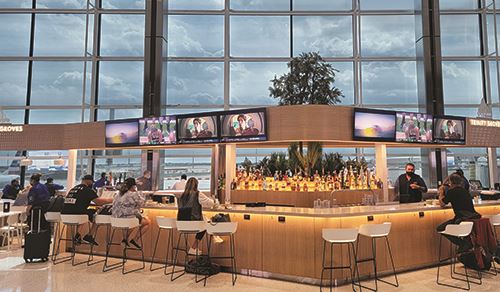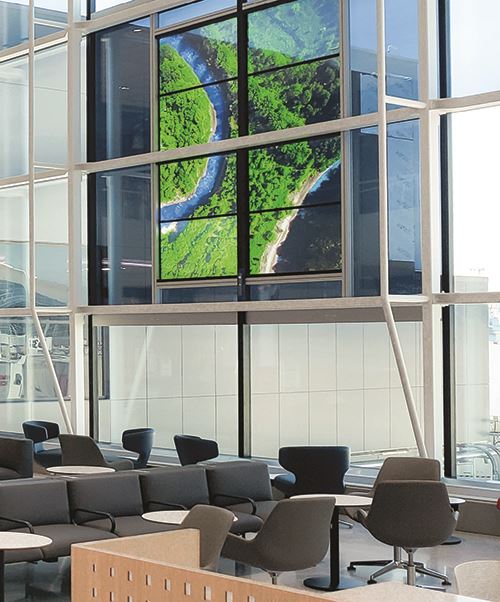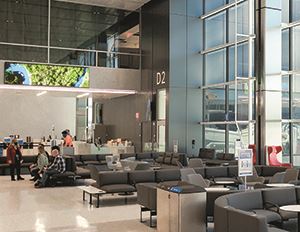This past May, Dallas Fort Worth International Airport (DFW) opened an extension of Terminal D, its primary international terminal. Although the $202 million project added just four gates, the impact on operational capacity and customer satisfaction is expected to be tremendous.
This past May, Dallas Fort Worth International Airport (DFW) opened an extension of Terminal D, its primary international terminal. Although the $202 million project added just four gates, the impact on operational capacity and customer satisfaction is expected to be tremendous.
 Khaled Naja, the airport’s executive vice president of Infrastructure and Development, says that the new extension, known as Terminal D South, is filled with technologies and amenities that provide customers with “moments of wow.” It is also designed to enhance the boarding process and reduce passenger stress.
Khaled Naja, the airport’s executive vice president of Infrastructure and Development, says that the new extension, known as Terminal D South, is filled with technologies and amenities that provide customers with “moments of wow.” It is also designed to enhance the boarding process and reduce passenger stress.
“Whatever we do at DFW, we always keep the customer first in mind,” explains Naja. “Our No. 1 priority is enhancing the customer experience.”
|
Project: Terminal Extension Location: Dallas Fort Worth Int’l Airport Site: Terminal D South Cost: $202 million Construction: July 2019- July 2021 Rolling Opening: Some domestic operations began in May 2021; int’l arrivals began in mid-June Architect of Record: Luis Vidal with HKA & Arup, joint venture LVHKA Project Manager: HNTB Construction: The Walsh Group (Archer Western), Phillips/May & Reyes Group Joint Venture
Passenger Boarding Bridges: Elevators: TK Elevator Escalators & Moving Walkways: TK Elevator Seating: KryptoMax; Global Furniture Group (Supra) Dynamic Glass: View Content Management System/Custom Digital Content: Synect Air Quality Monitors: ViewSense Concessions: Trinity Groves Smart Restroom System: Trax Analytics Lavatories: American Standard Toilet Partitions: ASI Global Partitions Water-Efficient Urinals: TOTO Faucets: Splash Lab by Lovair Stall Occupancy Lights: Tooshlights |
When Terminal D originally opened in 2005, it had 26 gates and was key to DFW’s plan for growing international arrivals and departures. But, it quickly became clear that the second-busiest airport in the United States would need even more gate space. Naja explains that two of DFW’s nine daily peaks caused traffic in Terminal D that was “beyond jam-packed” because that’s when most domestic connections as well as international arrivals and departures occurred.
To help alleviate the congestion, DFW added 140,000 square feet and four gates to the south end of Terminal D. “The day we opened up, the gates were full,” Naja reports.
In 2019, DFW served more than 75 million passengers. Fully 10 million flew in and out of Terminal D.
System Enhancements
In addition to providing operational relief, Terminal D South is designed to create a calm environment and experience for passengers. The project team prioritized comfortable seating and making sure that flight information can be seen from any location in the integrated gate area. Motion lights were also added to highlight the boarding process. As a whole, the approach is referred to as “gate of the future.” Airport and project executives describe it a logical evolution of the overall gate lounge concept.
“DFW has always been a trendsetter in trying new things,” says Naja. “Innovation is part of our DNA.” Importantly, management is not afraid of testing new concepts to determine how and where they work best, he adds.
One of the new concepts applied in Terminal D South is something he calls the “full digital experience.” The strategy focuses on using innovative technologies to optimize operational and energy efficiencies, while also improving the customer experience.
For instance, the airport partnered with View for three separate applications of smart glass. “DFW is an innovation partner for us,” says Kristi Crase, aviation strategy director for View. “They are a frontrunner and leader from an innovation perspective, and are very intentional about how they approach technologies.”
View Smart Windows are made of electrochromic glass, with a nanotech metal oxide coating that tints in response to electrical current. Using a predictive algorithm, View’s proprietary software analyzes a number of variables, including weather, outdoor temperatures, cloud cover, the amount of sunlight hitting a particular window and the location of interior passenger seating to proactively adjust each window’s tint to mitigate heat and glare throughout the day. In addition to providing unobstructed views for guests, the Smart Windows are designed to reduce energy consumption by eliminating up to 90% of solar heat gain in the terminal.

 Crase notes that changes in the tint of the glass are so subtle, building occupants do not notice them happening. “The net result is we’re maximizing the amount of natural light, but minimizing the negative impact of glare and heat,” she explains.
Crase notes that changes in the tint of the glass are so subtle, building occupants do not notice them happening. “The net result is we’re maximizing the amount of natural light, but minimizing the negative impact of glare and heat,” she explains.
At a busy airport like DFW, the high-tech glass helps maximize space, because guests can sit right next to the windows without overheating or needing to shield their electronic screens.
“We’re giving DFW back 100% of their real estate,” Crase remarks. “People naturally peel away from the windows if it’s hot or they can’t see. It’s improving the passenger experience.”
Another tech-forward feature is ViewSense, a system from the same company that monitors indoor environmental conditions. It provides DFW with real-time readings from dozens of sensors installed throughout Terminal D South that measure conditions such as air quality, carbon dioxide levels, volatile organic compounds, air temperature, humidity, light quality and noise levels. Using ViewSense, the airport can track activity throughout the airport and optimize conditions for customers and staff. For example, ViewSense can help staff identify and monitor high-traffic areas as carbon dioxide levels naturally rise when passengers queue at gates. Among other things, this prompts the airport to keep an eye on localized temperatures, which also tend to rise where passengers gather. “The HVAC might be set at 72, but at the gate it may be much warmer,” Crase relates.
The system also helps management assess how various technologies support the airport’s sustainability goals. Crase explains that ViewSense can integrate with the building management system, so it provides a deeper dive into efficiency measures than what is normally available.
Even though these new technologies won’t be visible to passengers, Naja is confident they will enhance their comfort, health and safety—and further improve the airport’s energy performance. “Typically when people think about customer experience, they think about offerings [tangible changes such as concessions and amenities],” he says. “We’re also improving how customers experience the terminal.”
The OLED displays, which are positioned to be clearly visible from anywhere in the integrated gate area, display color-coded boarding prompts. They work in concert with motion lights that help guide the boarding process and reduce stress for passengers.

The airport partnered with Synect to develop the content that runs on the screens and a system to manage it. Synect deployed its Passenger360® system and collaborated with DFW’s customer experience team, YCD Multimedia and local content creator DHD Films to develop a suite of custom digital material that includes still images, short videos, graphic displays and written information.
 “The curated elements work together to create an immersive lounge-like experience,” says Synect Founder and Chief Executive Officer Yahav Ran. “It’s a customer-centric approach that creates an intuitive ADA-compliant boarding experience with easily consumable visual instructions. There is also live-action content from the Dallas Fort Worth region that creates a memorable sense of place and ambient images that reflect the time of day and thrill of air travel.”
“The curated elements work together to create an immersive lounge-like experience,” says Synect Founder and Chief Executive Officer Yahav Ran. “It’s a customer-centric approach that creates an intuitive ADA-compliant boarding experience with easily consumable visual instructions. There is also live-action content from the Dallas Fort Worth region that creates a memorable sense of place and ambient images that reflect the time of day and thrill of air travel.”
Tech Literally Everywhere
The airport even leveraged technology to enhance concessions and restrooms.

Customers can use smartphones or kiosks to place orders for food and beverages from Trinity Groves, and choose to pick them up from a locker or have items delivered to them at a specific seat in the gate area. Traditional counter service is also available. Remote ordering and pick-up lockers are especially popular with COVID-cautious passengers who want to eliminate their interaction with concessions workers.
In the restrooms, Tooshlights above each stall indicate availability, and sensors in the paper towel and toilet paper dispensers alert maintenance personnel before supplies run out.
Touchless (and splashless) faucets, hand dryers and soap dispensers are energy-efficient and give customers peace of mind regarding germ spread. “We went through thorough analyses to find out what the customers care for and what touchless technologies we should include,” Naja relates.

Ultra water-efficient toilets and urinals support the airport’s commitment to sustainability.
COVID Complications
Construction on the project began in July 2019 and encountered typical supply chain issues caused by the coronavirus pandemic. Thomas Haag, vice president for The Walsh Group, reports that the construction team responded rapidly to the new challenges.
 “We kept moving full-speed ahead, but had to quickly adapt and develop new best practices for addressing the pandemic and mitigating risk,” Haag remarks. Extra measures included frequent health screenings for employees, new social distancing policies, split shift work schedules and contact tracing. “We worked hand-in-hand with all partners to make sure best practices were being broadly adopted across the campus,” he adds.
“We kept moving full-speed ahead, but had to quickly adapt and develop new best practices for addressing the pandemic and mitigating risk,” Haag remarks. Extra measures included frequent health screenings for employees, new social distancing policies, split shift work schedules and contact tracing. “We worked hand-in-hand with all partners to make sure best practices were being broadly adopted across the campus,” he adds.
Amid the global pandemic, DFW also experienced 12 days of record cold in February 2021 that crippled much of Texas. Naja gives high marks to the entire project team for the partnership and leadership displayed in the face of both unusual challenges. “The job was still delivered on time, and it was top-shelf quality,” he reports.
Sweet Success
With Terminal D already at peak capacity before the expansion project began, airport officials stressed that new construction could not negatively impact operations. In particular, an existing underground tug tunnel that connects the two sides of the airport had to remain in operation 24/7 throughout the project. This required crews to build over and around the tug tunnel, preserving it as an active airport operations area.
A rolling opening of Terminal D South allowed domestic operations to begin in early May 2021, and the new facility fully opened for international arrivals on June 12. “We were just trying to keep up with American Airlines’ growing operations,” relates Christopher Arman, program director/senior vice president at HNTB. Daily coordination calls about progress and when the airline could establish crew schedules were consequently crucial.
As demand at DFW continues to grow, officials are looking ahead to the addition of nine new gates in terminals A and C, and renovations to Terminal C, announced in early August.


 facts&figures
facts&figures

